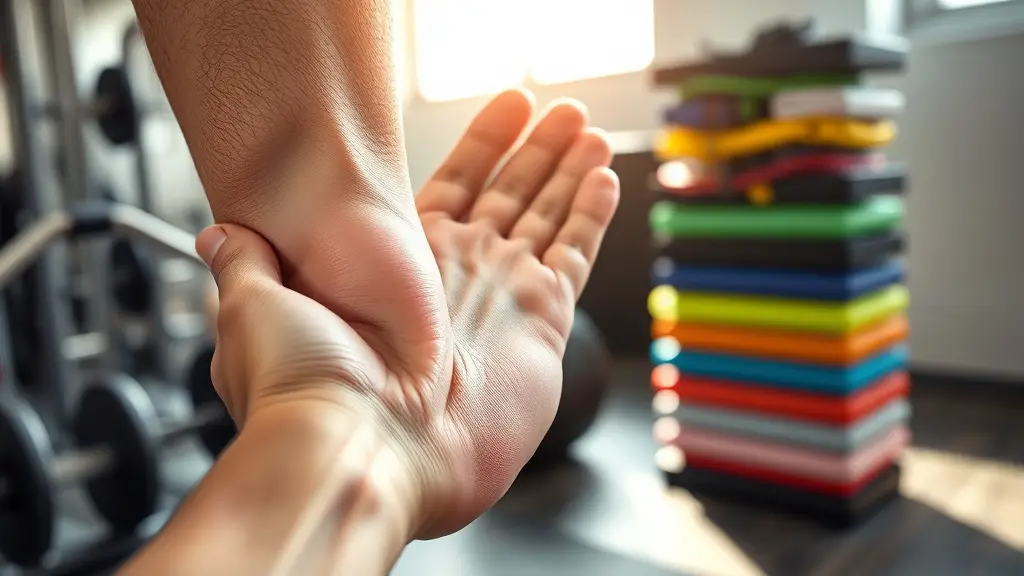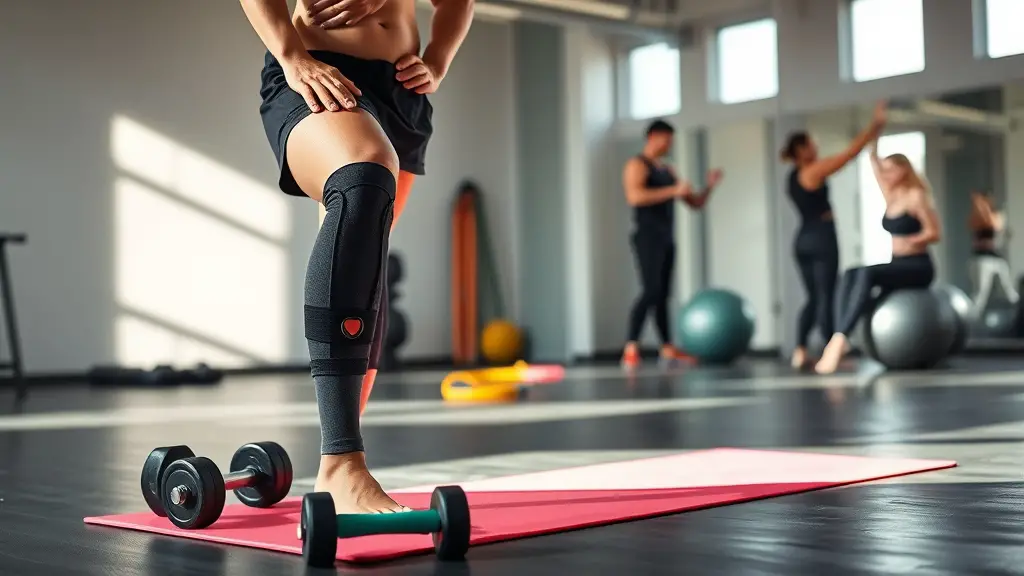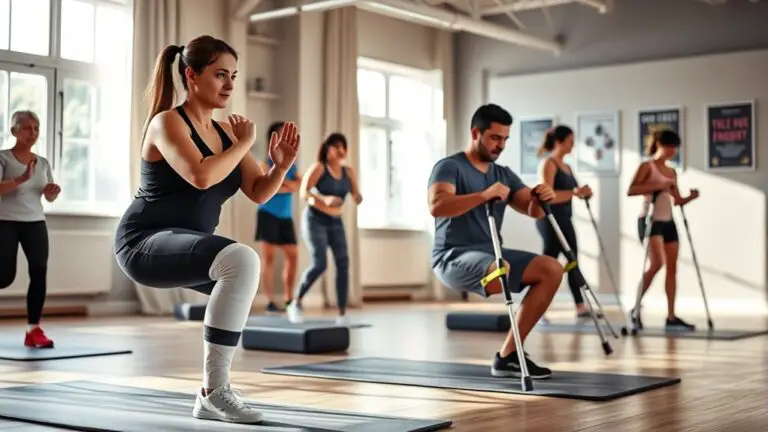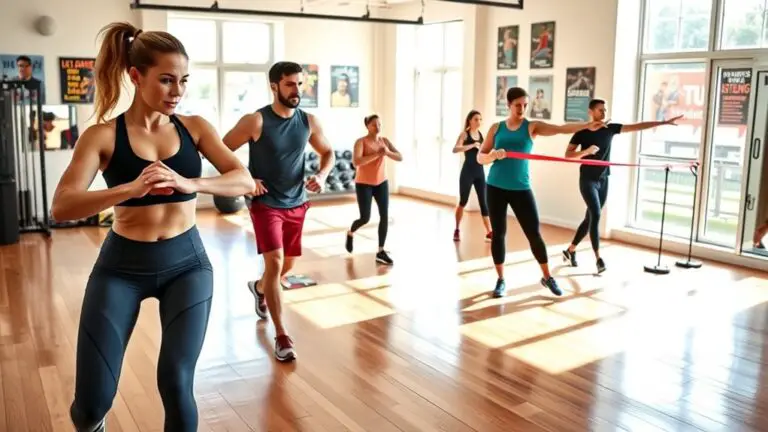How to Recover From a Gym Injury and Get Back to Training

To recover from a gym injury and return to training, start by evaluating the injury’s type and severity. Use the R.I.C.E. method: Rest, Ice, Compression, and Elevation, for immediate care. Listen to your body, recognizing pain signals to avoid further damage. Gradually resume training with low-impact activities while focusing on nutrition for muscle repair and inflammation reduction. Setting realistic goals can keep you motivated. There’s more you can explore to guarantee a safe and effective recovery journey.
Understanding Your Injury: Types and Severity

When you sustain a gym injury, understanding the type and severity is vital for effective recovery. Acute injuries, like sprains or fractures, occur suddenly during activity, while chronic injuries develop over time due to repetitive strain. Conducting a thorough injury assessment is important for accurate symptom identification, which helps determine the appropriate course of action.
Recovery timelines will vary based on injury types, with acute injuries generally requiring shorter recovery periods compared to chronic injuries. Effective pain management strategies, including over-the-counter medications and ice application, can aid in alleviating discomfort.
Once the initial pain subsides, rehabilitation techniques, such as physical therapy or targeted exercises, can facilitate healing and restore function. By understanding your injury’s nature and severity, you’ll be better equipped to navigate your recovery process and return to your fitness routine safely and effectively.
Initial Steps: R.I.C.E. Method for Immediate Care
When you experience a gym injury, taking immediate action is essential for effective recovery. The R.I.C.E. method—Rest, Ice, Compression, and Elevation—provides a structured approach to manage your injury right after it occurs. By following these steps, you can minimize swelling and promote healing, setting the stage for a smoother recovery process.
Rest and Immobilization
Although experiencing a gym injury can be distressing, taking immediate steps to care for it is vital for a swift recovery. Rest is essential during this time; aim for at least 24-48 hours of rest duration, depending on the severity of your injury. Immobilization techniques, such as using a brace or wrap, can help stabilize the affected area, preventing further damage.
Here’s a quick reference table for your recovery:
| Rest Duration | Immobilization Techniques |
|---|---|
| 24-48 hours | Compression bandages |
| 48-72 hours | Splints or braces |
| 3-7 days | Taping for stability |
| 1-2 weeks | Slings for upper body injuries |
| 2+ weeks | Physiotherapy recommendations |
Ice Application Techniques
Applying ice to an injured area is vital for reducing swelling and alleviating pain. Utilize effective ice pack techniques to guarantee therapeutic benefits. Start by wrapping an ice pack in a thin cloth to protect your skin from frostbite. Apply it directly to the injured area for 15-20 minutes every hour during the first 48 hours. You can also use cold therapy methods like a bag of frozen peas, as they mold well to your body’s contours. Remember to take breaks between applications to allow your skin to warm up. Consistent ice application helps manage inflammation and promotes healing, making it a vital component of your recovery process. Follow these guidelines to maximize the effectiveness of your ice therapy.
Compression and Elevation
Compression and elevation are fundamental components of the R.I.C.E. method, which stands for Rest, Ice, Compression, and Elevation. These initial steps are imperative for managing injuries.
- Compression Techniques: Use elastic bandages or compression sleeves to minimize swelling. Apply firm pressure without cutting off circulation.
- Elevation Benefits: Elevate the injured area above heart level to reduce swelling and promote blood flow, aiding recovery.
- Duration: Maintain compression and elevation for 48 hours post-injury, adjusting as needed based on comfort and swelling levels.
Incorporating these methods can greatly enhance your healing process. Remember, if pain persists or worsens, seek professional medical advice to guarantee appropriate treatment. Taking these steps is essential for getting back to your training safely.
Seeking Professional Help: When to Consult a Doctor
When you’re dealing with a gym injury, knowing when to seek professional help can be essential for your recovery. If you experience persistent pain, swelling, or any symptoms that worsen over time, it’s time to consult a healthcare provider. A thorough symptom assessment can help identify the severity of your injury and guide your treatment options. If you can’t move a joint or if you feel sharp pain, these are clear signals that professional intervention is necessary.
Don’t hesitate to explore your referral options; a physical therapist or sports medicine specialist can provide targeted rehabilitation strategies tailored to your needs. Early intervention greatly impacts recovery time and can prevent long-term complications. Remember, getting expert advice isn’t just about treatment; it’s about understanding your body better and ensuring a safe return to training. Prioritizing your health now will pay off in the long run.
Listening to Your Body: Recognizing Pain Signals

Understanding your body’s signals is essential for effective recovery from a gym injury. Listening to your body aids in recognizing pain and preventing further damage. Here are three key components to focus on:
Listening to your body is crucial for recovering from gym injuries and preventing further damage.
- Identify Pain Types: Distinguish between acute pain, which may indicate injury, and soreness from exertion. Acute pain usually requires immediate attention.
- Practice Body Awareness Training: Engage in exercises that enhance your connection with physical sensations. This can improve your ability to detect subtle changes in your body.
- Implement Pain Management Techniques: Utilize methods such as ice, rest, or gentle stretching to alleviate discomfort. Understanding what works for you is vital.
Gradual Return: Developing a Safe Training Plan
As you begin to recover from a gym injury, it’s essential to develop a training plan that prioritizes safety and gradual progression. Start by evaluating your current physical capabilities and identifying which exercises you can perform without pain. Focus on low-impact activities that promote healing while maintaining some level of fitness.
Gradually increase your training intensity, ensuring that each increment is manageable. This might mean starting with lighter weights or shorter durations, then slowly incorporating more challenging exercises as your body adapts. Keep a training log to track your progress and any discomfort.
It’s vital to listen to your body throughout this process; if you experience any pain, reduce your intensity and allow more time for recovery. By following a structured approach, you’ll minimize the risk of re-injury and set yourself up for long-term success in your fitness journey.
Cross-Training: Alternatives to Maintain Fitness

When recovering from a gym injury, cross-training can help you maintain your fitness while minimizing strain on your body. You can explore low-impact cardio options, modify your strength training, and incorporate flexibility and mobility work into your routine. These alternatives not only support your recovery but also help keep your overall fitness levels intact. Additionally, incorporating low impact alternatives like exercise bands can provide a full-body workout while reducing stress on your joints.
Low-Impact Cardio Options
Although recovering from a gym injury can be frustrating, incorporating low-impact cardio options into your routine can help you maintain fitness without exacerbating your condition. Here are some effective choices:
- Swimming Laps: This full-body workout is gentle on joints and can improve cardiovascular health.
- Elliptical Trainer: This machine simulates running without the impact, making it easier on your body.
- Aqua Jogging: Running in water reduces strain while allowing you to maintain endurance.
Other options include stationary biking, using a rowing machine, or engaging in dance cardio. You might also consider walking programs or exploring hiking trails that accommodate your recovery. These activities can keep your heart rate up while providing necessary support during your healing process.
Strength Training Modifications
Incorporating strength training modifications into your recovery plan can be crucial for maintaining fitness without aggravating your injury. Focus on exercise modifications that allow you to work around your limitations while still targeting muscle groups. For instance, if lower-body movements are painful, consider upper-body exercises or resistance bands for light strength training. Bodyweight exercises can also be effective, as they generally place less stress on injured areas. Remember to prioritize proper form and engage in exercises that don’t exacerbate your condition. Gradually introduce modified strength training routines to maintain muscle tone and cardiovascular health. Always consult a healthcare professional or a certified trainer to verify your modifications are safe and effective during your recovery journey.
Flexibility and Mobility Work
Maintaining flexibility and mobility is essential during your recovery from a gym injury, especially as you modify your strength training routines. Incorporating cross-training activities can help you stay fit while promoting healing. Consider the following:
- Dynamic stretching: Engage in dynamic stretches to enhance blood flow and prepare your muscles for movement, which aids joint mobility.
- Foam rolling: Utilize foam rolling techniques to alleviate muscle tension and improve flexibility routines, promoting better overall recovery.
- Yoga practices: Integrate yoga into your active recovery sessions to enhance flexibility and balance, supporting your body’s healing process.
Nutrition for Recovery: Fueling Your Body

When you’re recovering from a gym injury, proper nutrition plays an indispensable role in healing and regaining strength. Focus on adequate protein intake to repair muscles and include anti-inflammatory foods to reduce swelling. Hydration strategies are essential; staying well-hydrated facilitates nutrient distribution. Nutrient timing is critical; consume whole foods, recovery smoothies, and vitamins supplementation around your training sessions.
Here’s a simple meal planning table to guide you:
| Meal Type | Examples | Benefits |
|---|---|---|
| Breakfast | Oatmeal with berries | Fiber and antioxidants |
| Snack | Greek yogurt with nuts | Protein and healthy fats |
| Lunch | Quinoa salad with veggies | Whole grains and vitamins |
| Dinner | Grilled salmon with broccoli | Omega 3 benefits |
| Post-Workout Shake | Protein smoothie | Quick recovery and muscle repair |
Incorporate these strategies into your meal prepping to enhance recovery.
Mental Resilience: Staying Positive During Recovery
While recovering from a gym injury, cultivating mental resilience is essential for staying positive and motivated. Developing mental strength during this time can greatly enhance your recovery process. Here are three strategies to foster a positive mindset:
- Set Realistic Goals: Break your recovery into manageable milestones. Celebrate small achievements to maintain motivation and focus on progress rather than setbacks.
- Practice Mindfulness: Engage in mindfulness exercises such as meditation or deep breathing. These techniques can help you manage stress, reduce anxiety, and maintain a balanced perspective on your recovery journey.
- Seek Support: Surround yourself with a supportive network. Share your feelings and progress with friends, family, or a coach, as their encouragement can help reinforce a positive mindset.
Injury Prevention: Strengthening and Conditioning

To prevent injuries, it’s essential to incorporate strengthening and conditioning exercises into your routine. By focusing on preventive exercises, you enhance your injury awareness and overall performance. Conditioning routines that include muscle strengthening, balance training, and core stability can considerably reduce injury risks. Additionally, incorporating flexibility drills helps maintain your range of motion and prevents muscle tightness. Remember that hammer curls are not essential for muscle development, but they can contribute to balanced muscular development in the arms.
Here’s a table to illustrate effective exercises:
| Type of Exercise | Example | Benefits |
|---|---|---|
| Strengthening | Squats and Deadlifts | Increases muscle strength |
| Balance Training | Single-leg Stands | Improves stability |
| Core Stability | Planks | Enhances core strength |
| Flexibility Drills | Dynamic Stretching | Enhances flexibility |
Don’t forget to implement proper warm-up techniques before workouts. By following these guidelines, you’ll considerably reduce the risk of injury and enjoy a safer training experience.
Setting Realistic Goals: Tracking Progress After Injury
As you recover from a gym injury, setting realistic goals becomes essential for both motivation and progress. Effective goal setting can help you regain confidence and track your recovery. Here are three steps to guide your progress tracking:
- Define Short-Term Goals: Focus on attainable objectives, like regaining full range of motion or gradually increasing your activity level.
- Monitor Your Progress: Keep a journal or use an app to document your workouts, noting any improvements or setbacks. This will help you stay accountable and adjust your goals as needed.
- Celebrate Milestones: Acknowledge your achievements, no matter how small. Celebrating these moments reinforces your commitment and boosts your motivation.
Frequently Asked Questions
How Long Will It Take to Fully Recover From My Injury?
Think of recovery like a puzzle; each piece takes time to fit perfectly. The recovery timeline varies based on your injury severity. Minor strains might heal in a few weeks, while more serious injuries could take months. You’ll need patience and proper care to guarantee all pieces come together. Listening to your body and following professional advice can help speed things up, but rushing it might lead to setbacks. Stay committed, and you’ll get there!
Can I Use Ice or Heat for My Injury?
You can definitely use both ice and heat for your injury, but it’s important to know when to apply each. Ice therapy is great for reducing swelling and numbing pain, especially in the first 48 hours after an injury. On the other hand, heat application can help relax and loosen tissues, promoting blood flow to the area. Just make sure to avoid using heat on any swollen areas to prevent further inflammation.
What Signs Indicate My Injury Is Worsening?
When evaluating your injury, watch for signs that indicate it’s becoming more severe. An increase in pain intensity, especially if it becomes sharp or throbbing, is a key indicator. Additionally, if you notice swelling increase around the affected area, that’s a red flag. These symptoms suggest that your body may be struggling to heal properly. It’s important to listen to these warning signs and consult a healthcare professional if they occur.
Are There Specific Supplements That Aid Recovery?
When you’re on the path to recovery, think of your body as a ship in need of repair. Protein powders can be the sturdy planks that help rebuild your vessel, while recovery drinks serve as the nourishing winds, propelling you forward. These supplements provide essential amino acids and hydration, vital for muscle healing. Incorporating them into your routine can greatly enhance your recovery, helping you feel stronger and ready for what’s next.
How Can I Stay Motivated During My Recovery Process?
Staying motivated during recovery can be challenging, but effective goal setting is essential. Break your recovery into smaller, achievable milestones, and celebrate each one. Incorporating positive affirmations into your daily routine can also boost your mindset; remind yourself of your strength and progress. Surround yourself with supportive individuals and stay connected with your fitness community, as their encouragement can help keep your spirits high throughout the recovery process.





